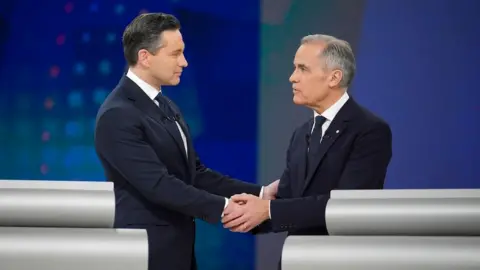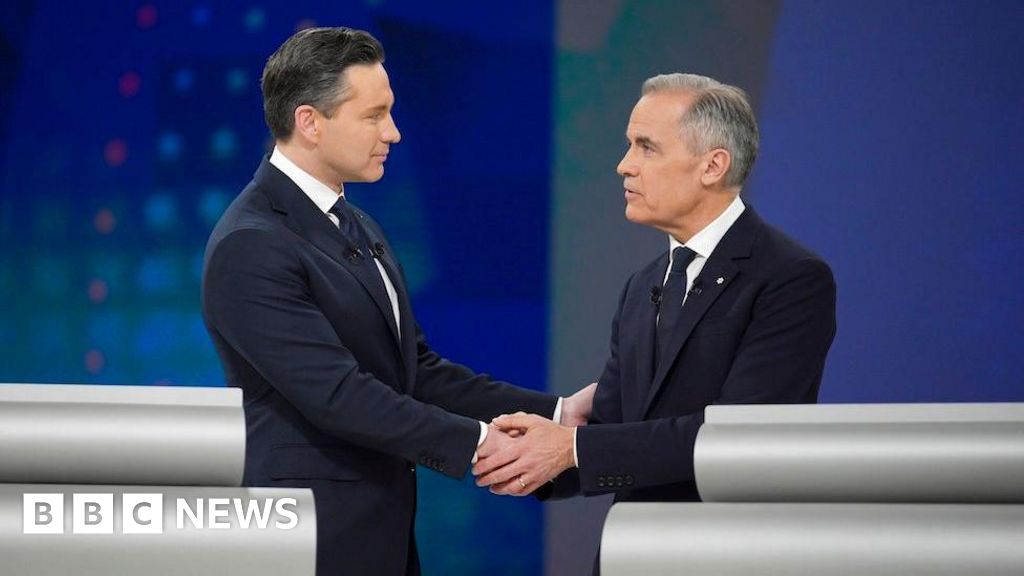BBC News
 Christopher Katsarov / POOL
Christopher Katsarov / POOLThe leaders of Canada’s four major federal parties squared off in their second and final debate ahead of this month’s general election, but someone off stage stole most of the spotlight: US President Donald Trump.
A big question heading into the debate was whether Liberal leader Mark Carney, who has been leading comfortably in the polls, would stumble.
Carney had managed to survive Wednesday’s French debate despite his shaky French language skills.
On Thursday, he was put on the spot numerous times by his three opponents: Conservative leader Pierre Poilievre, New Democratic Party leader Jagmeet Singh and Bloc Quebecois leader Yves-Francois Blanchet.
How to respond to Canada’s ongoing trade war with the US was a recurring theme, but the debate also featured spirited discussions on other issues facing Canada, like affordability, crime and the environment.
Here are five big takeaways from Thursday’s face off:
The ghost of Justin Trudeau haunts Carney
As Carney leads in the polls, his opponents honed in on the mistakes of his unpopular predecessor, former Prime Minister Justin Trudeau.
Conservative leader Poilievre made references to the “lost Liberal decade”, referencing the last 10 years in which the Liberal party has been in power. He used issues like housing affordability and the high cost of living to drive this point home.
“How can we possibly believe that you are any different?” Poilievre asked Carney directly.
Blanchet also threw down the gauntlet to Carney. “You claim you are different – you need to prove you are better.”
Carney was forced to defend himself multiple times, noting that he has only been in the prime minister’s chair for one month despite sharing the same party banner as Trudeau.
“I am a very different person than Justin Trudeau,” Carney said. At times, he appeared to criticise his predecessor’s governance, saying that a Liberal party under his leadership will be more focused on delivering results.
A softer approach to Donald Trump’s tariffs
At the top of the hour, the leaders were asked about how they would negotiate with President Trump and respond to his tariffs on Canada.
Trump has implemented blanket 25% tariffs on goods from Canada, with an exemption on products covered by the USMCA – a North American free trade deal. Canada is also hit with global US tariffs on steel and aluminium and cars.
The president has also publicly mused about Canada becoming the 51st US state.
Canada’s government had previously said that its position is to implement “dollar-for-dollar” tariffs in retaliation to Trump, with the aim of inflicting maximum pain on the US economy.
But during the debate, the leaders appeared to contend with the fact that Canada’s economy is dwarfed by that of the US, and that it is ultimately not an equal fight.
“We’ve moved on from dollar-for-dollar tariffs,” Carney said, acknowledging that the US economy is more than 10 times larger than Canada’s.
Instead, he said that if elected, his government would focus on incentivising businesses to stay in Canada in order to protect jobs in the country. That doesn’t mean retaliatory tariffs are off the table. Rather, the Liberal leader said the focus would shift to targeted tariffs that would maximise pain on the US and hurt Canada as little as possible.
Trump appears to have softened his language on Canada in recent weeks. After a phone call with the US president in late March, Carney said Trump “respected Canada’s sovereignty” and said their conversation was “constructive”.
“We had a very good conversation,” Trump said afterwards, noting that Canada is in the middle of an election and that he would meet with the winner afterwards.
The devil is in the (policy) details
For Canadians deeply tuned into the issues facing the country beyond Trump and his tariffs, the debate offered substantive policy discussions on an array of topics, from housing to crime to immigration.
The leaders were often passionate about the specifics of their plans, as well as the ideologies that inspire them. And it was clear that Canadians have starkly different choices before them.
Poilievre frequently championed his vision of a small government that would keep taxes low to drive up economic growth and affordability for Canadians, and that would be tough on crime.
Singh, meanwhile, took several opportunities to push for stronger social programmes in Canada, including expanding the country’s national dental care and pharmacare programmes and bolstering spending on healthcare.
Carney stuck close to the centrist point of view of his party, and took the time to list his proposals on how Canada could restore housing affordability, fight off Trump and strengthen its economy. “Government can play a role, but its role has to be catalytic,” he said during a debate segment on strong leadership in a crisis.
Blanchet, leader of the Bloc Quebecois, unsurprisingly used his airtime to advocate for Quebec’s distinct place in Canada and for the protection of its French identity.
“I don’t want to be the leader of Canada,” he noted transparently. The party supports the eventual separation of Quebec from Canada, and carries no seats outside the province. But if it wins a number of seats, it can become a powerful voting block in parliament.
Smaller parties fight for air time – and survival
Canada’s political system, similar to that of the UK, features multiple political parties: the centre-left Liberals, the right-leaning Conservatives, the left-leaning New Democrats, and the Bloc Quebecois which only runs candidates in the French-speaking province of Quebec. There is also the Green Party, which was disqualified at the last minute from the debate for not running enough candidates.
This means that Canadians have ample choice as they head to the voting booth.
But polls show this election might be more polarised than ever. The bulk of Canadians are opting to support either the Conservative party or the Liberal party, with the election turning largely into a contest between the two.
This has left the remaining parties fighting for survival. National polls have Singh’s New Democrats polling at 8.5% – which would roughly translate into just five seats out of 343, a major loss from their current 24 seats.
That fight was apparent during the debate for Singh, who visibly pushed to make his voice heard and interrupted both Poilievre and Carney multiple times in an attempt to set his party apart as the choice for progressive voters in Canada.
Meanwhile, Bloc Quebecois leader Blanchet inserted issues relevant to the French-speaking province at every opportunity.
His party, too, stands to lose at least a dozen seats in Quebec, according to current polling, with many opting to vote for the Liberals instead as they believe the party is better equipped to deal with Trump and his threats.
Both Singh and Blanchet made the case that they need to be a check on any governing party. “You can’t entrust all the power to Mr Carney,” Singh remarked.
Canadian politeness on display
There were interruptions, spirited discussions and even the occasional lines of attack. But overall, the tone from the four federal leaders was rather cordial.
That effort to keep the conversation measured was apparent at one point as the leaders were discussing the housing crisis in Canada. In a rebuttal to Poilievre, Carney appeared to stop himself before laying into his opponent.
“A misunderstanding —” Carney said as he paused mid sentence, adding: “I’ll be polite.”
Even after some heated exchanges between the two leaders, Carney and Poilievre were filmed shaking hands and exchanging a couple of laughs afterwards.
Overall, it was a strikingly different scene to those who have watched recent presidential debates in the US. It was even friendlier than some past Canadian federal debates, which featured different Liberal and Conservative candidates.
Read full article at source
Stay informed about this story by subscribing to our regular Newsletter



